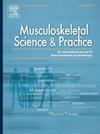Optimizing safety in conservative physical management of the cervical spine: A modified Delphi study
IF 2.2
3区 医学
Q1 REHABILITATION
引用次数: 0
Abstract
Background
Conservative cervical spine treatment is generally safe, but serious adverse events (SAEs) still occur despite various available clinical guidelines. There have been several challenges in understanding the specific circumstances of these events to direct prevention such as inconsistent reporting, misuse of professional titles, and incomplete data. There are also differences in opinions between professions. It is now important to understand expert views and consensus across professions regarding prevention strategies and minimum requirements for reporting standards for future SAEs.
Methods
A modified Delphi method was used, involving 28 international experts from various allied health professions, including chiropractic, physiotherapy, osteopathy, and medicolegal fields. The experts took part in three rounds of online surveys to reach a consensus on reporting, characteristics, risk factors, and prevention of SAEs associated with neck treatments. An agreement of >74 % was required before consensus was reached.
Results
Consensus was reached for more standardised reporting of SAEs across different types of treatments and professions. Addressing underlying health conditions and improving the recognition of potential risks, precautions, and contraindications during treatment were highlighted. Recommendations for strategies to improve safety, including early identification of risk factors and careful application of techniques, especially in vulnerable populations were also provided.
Conclusion
Experts called for the development of universally accepted clinician friendly clinical guidelines that focus on improving SAE reporting, early identification of SAEs, and safer technique application, particularly in special populations. Implementing these recommendations will help reduce the occurrence of SAEs and improve the safety of conservative cervical spine management across professions.
优化颈椎保守物理治疗的安全性:一项修正的德尔菲研究
背景:保守的颈椎治疗通常是安全的,但尽管有各种可用的临床指南,仍然会发生严重的不良事件(sae)。在了解这些事件的具体情况以直接预防方面存在一些挑战,例如报告不一致、职称滥用和数据不完整。不同职业之间的观点也存在差异。现在重要的是了解专家的意见和跨专业的共识,关于预防战略和未来SAEs报告标准的最低要求。方法采用改进的德尔菲法,对28名来自脊椎指压、物理治疗、整骨疗法和医学法律等专业的国际专家进行调查。专家们参加了三轮在线调查,以就报告、特征、风险因素和与颈部治疗相关的SAEs预防达成共识。在达成共识之前,需要达成74%的一致意见。结果在不同类型的治疗和专业中达成了更标准化的SAEs报告的共识。强调了解决潜在健康状况和提高对治疗期间潜在风险、预防措施和禁忌症的认识。会议还提出了改善安全的战略建议,包括及早查明危险因素和谨慎应用技术,特别是在脆弱人群中。专家呼吁制定普遍接受的临床医生友好的临床指南,重点是改善SAE报告,早期识别SAE,以及更安全的技术应用,特别是在特殊人群中。实施这些建议将有助于减少SAEs的发生,并提高各行业保守颈椎管理的安全性。
本文章由计算机程序翻译,如有差异,请以英文原文为准。
求助全文
约1分钟内获得全文
求助全文
来源期刊

Musculoskeletal Science and Practice
Health Professions-Physical Therapy, Sports Therapy and Rehabilitation
CiteScore
4.10
自引率
8.70%
发文量
152
审稿时长
48 days
期刊介绍:
Musculoskeletal Science & Practice, international journal of musculoskeletal physiotherapy, is a peer-reviewed international journal (previously Manual Therapy), publishing high quality original research, review and Masterclass articles that contribute to improving the clinical understanding of appropriate care processes for musculoskeletal disorders. The journal publishes articles that influence or add to the body of evidence on diagnostic and therapeutic processes, patient centered care, guidelines for musculoskeletal therapeutics and theoretical models that support developments in assessment, diagnosis, clinical reasoning and interventions.
 求助内容:
求助内容: 应助结果提醒方式:
应助结果提醒方式:


